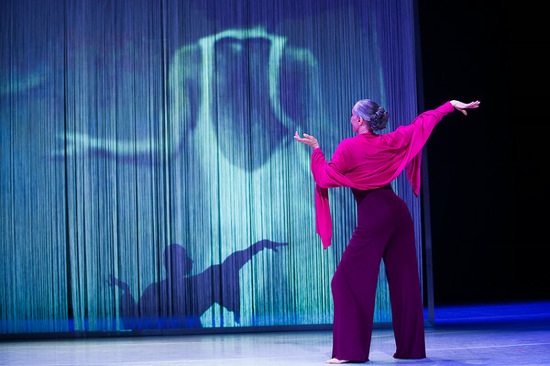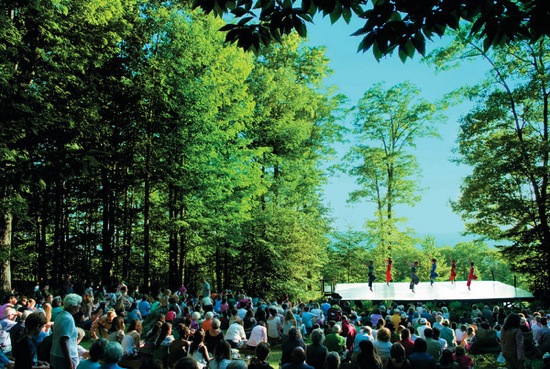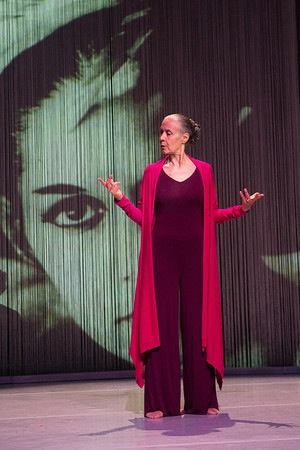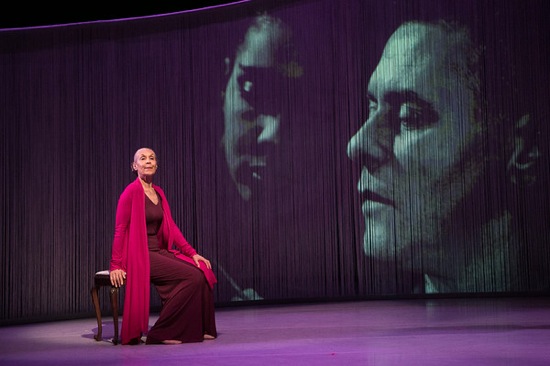Jacob’s Pillow opens its summer season with a solo performance by Carmen de Lavallade.
The Gala that opened the Jacob’s Pillow Dance Festival’s summer season was full of goodies—and by that I don’t mean just the dinner and the whooping it up on the dance floor. The program opened in the Ted Shawn Theater with the 22 students in the Pillow School’s Ballet Program performing an astounding pièce d’occasion by Jessica Lang, set to two movements of a Vivaldi concerto. Hard to believe that Lang and the cast had created the work, with its sleek, changeable patterns and contrapuntal wizardry in just four days. Representatives of the three companies to be featured in the upcoming months performed (The Hong Kong Ballet, The McIntyre Project, and John Heginbotham, who accepted the Jacob’s Pillow Dance Award with a frisky solo). Then there was Carmen de Lavallade.
Suddenly we are in the woods. The back doors of the stage have been opened to frame greenery. The audience gasps. De Lavallade, walking onto the stage in a long, flowing red gown (designed by her husband, Geoffrey Holder), stops to drink it in, before performing a sequence from Holder’s The Creation in which God, still feeling lonely, makes a man for himself out of the earth that he dreamed up a few days ago. The trees we contemplate begin to seem part of the Genesis creation myth, as this inimitable performer casts her spell.
De Lavallade accepts her age with uncommon grace (which is not to say she embraces its difficulties). It’s all right with her that, the following week, the Pillow’s director, Ella Baff, mentions in her speech introducing de Lavallade’s solo performance, As I Remember It, that Carmen is one year older than Jacob’s Pillow—83, in fact.
I’ve seen de Lavallade in several settings—dancing onstage; walking down 6th Avenue on her way to City Center, all dressed up and looking the way any queen would like to look; and backstage at a couple of performances she and I both took part in. So: accomplished, gorgeous, and down to earth (as in such exchanges as: “Anyone have an extra safety pin?” and “Can you please help me with this hook?”). As I Remember It shows her in all these aspects, as well revealing her as a smart, thoughtful, and witty person.
Watching and listening to de Lavallade in this hour-long performance that she crafted with Talvin Wilks (dramaturg/co-writer), Joe Grifasi (director), and Dianne McIntytre (movement consultant), we learn that she was first cousin to Janet Collins, the first black woman to become the prima ballerina of the Metropolitan Opera Ballet. And we accompany her travels from a Los Angeles childhood through her career as a dancer on concert stages, in Broadway shows, and in movies, to her choreography and her appearances in recent years in Paradigm with Gus Solomons jr and Dudley Williams. Mimi Lien’s ingenious set—a tall, slanted “wall” of shimmering threads—receives Maya Ciarrocchi’s montages of archival photos and films.
Wearing a handsome, burgundy-colored pants outfit and a fuschia-pink coat designed by Esther Arroyo, de Lavallade moves around the performing space of the Doris Duke Studio Theater, re-entering her past and sharing her memories. Sometimes she sits, erect yet at ease, on a cushioned stool; sometimes she strides about or sinks into remembered dance steps and gestures. She may walk at times as if her toes were stiff (I share her pain), and at other times rush about like a girl or push aside the hanging tendrils to make a grand entrance. In addition to the visual material and James F. Ingalls’ lighting, music (composed by Jane Ira Bloom) and Christopher J. Bailey’s sound design bring out aspects of her long, rich journey of a career.
It’s not possible to learn everything you’d like to know about her and how she felt and what she learned in the space of a single performance. A lot of famous people make only cameo appearances and/or are mentioned briefly. Some of these are memorable; Duke Ellington kissed her twice on each cheek, murmuring that the caresses were intended for all of her cheeks.
People who don’t know much dance history can learn about de Lavallade’s growing up in Los Angeles (the first dance she learned was the Mexican Hat Dance, which she demonstrates a bit of) and her years in the company of West-Coast modern dance pioneer Lester Horton, who died prematurely in 1953. Horton’s dancers—who sewed costumes, made sets, and learned about a lot of things—included Alvin Ailey, a high-school buddy of Carmen’s whom she had lured into dance. De Lavallade takes off her jacket and ties it around her hips as she tells the story and indicates the action of Horton’s Salome, whose title role she took over as a teenager from Bella Lewitsky when Lewitsky parted ways with Horton. She makes us envision, as if through a veil, her youthful self as she seduces a guard, swings her hips for Herod, and is strangled by her own scarf. She is a master of the subtly telling gesture and timing, as well as gutsy when that’s called for.
Ailey and de Lavallade came together to New York in 1954 to dance in House of Flowers, a Harold Arlen musical based on a Truman Capote short story. And it was in House of Flowers that she first encountered her husband-to-be, Geoffrey Holder. A black-and-white film clip shows the two of them—she young and sassy, he tall, slim as a snake, and as flexible as one.
Oh, those 1950s film images and photographs! Who knew that de Lavallade had danced in South Sea Woman (Horton provided the choreography)? Or in Demetrius and the Gladiators? Or in Lydia Bailey (choreography by Jack Cole)? There she is dancing a passionate duet on a beach with Ailey, who briefly took over the Horton company after its founder’s death. Here’s a snapshot of her in a dressing room, sewing a costume, while Holder’s and her infant son, Leo, slumbers beside her in a nest of fabric.
She tells, without overt rancor, of encountering racism when she and Glen Tetley, both dancers with John Butler’s New York company, were to dance to the song “Willow Weep for Me” on the Ed Sullivan Show. A black woman and a white man could not be seen dancing together. Claude Thompson of the Ailey company replaced Tetley.

As I Remember It: Carmen de Lavallade converses with her shadow and an image from a dance she appeared in. Photo: Christopher Duggan
It’s enthralling to see de Lavallade fall in with movements she sees on screen and hint at some steps she performed—as if they’re flickering through her body—and then deliver certain gestures with full power. Her eloquent speaking aids her too. For a time, she was part of Robert Brustein’s Yale Repertory Theater, and it shows. Several times, she slips into Shakespeare’s words, echoing Titania’s “These are the forgeries of jealousy” speech just after we see a poster for an early tour, with her name mast-heading a group just before Ailey’s, and shortly before the beach duet.
Near the end of As I Remember It, de Lavallade speaks a few resigned words to us. They are not hers, but drawn from Robert Lowell’s translation of “The Old Lady’s Lament for Her Youth,” a 15th-century poem by François Villon. “Oh treacherous, fierce old age,” she says, and “Once I was beautiful. . .[shrug] That’s how it goes with us.” But shortly after that, she invokes a more colloquial, centuries-later poet, Don Marquis, and a line she delivered as the old alley cat Mehitabel to Solomons’ cockroach Archie in Paradigm’s 2008 3 Scenes from Archie and Mehitabel : “wotthehell wotthehell/ there s a dance in the old dame yet.” I don’t remember if she said the last part of the line at Jacob’s Pillow, but it was, for sure, implied.
Carmen de Lavallade is—so what?—in her ninth decade, but any comparison of her to a broken-down whore or a scraggly explorer of garbage cans is laughable. She’s a beautiful woman with a quicksilver mind and gestures. Dance has taken up permanent residence in her.




i am one of the lucky ones who are still alive and can say i saw carmen de lavallade dance with the lester horton dance theater company in their los angeles head quarter many many years ago.. she was then and indeed now truely one of the great performing artist from the united states. she never looks wrong in what ever she danced, rather like a royal performer she was that role….. alas i live abroad now but would so have loved to see this one woman show that you discribe so well. i only hope that she will continue forever to make us respect the dance she performs and the artist she is.
Ahhh, Deborah, you invite memories of Carmen de Lavallade and do I ever have them, on stage and off. I saw her dance at New York City Center in Butler’s Carmina Burana–never before or since has the woman (girl?) in the red vest been so sensuous, so sexy. We had a quick breakfast together (along with some other people) at the Millennium Conference on Dance in 2000, and I ran into her at the Dance Magazine Awards in 2006 when Todd Bolender was given his posthumously (he died weeks before that ceremony at 92) and with tears running down my cheeks I asked her if she had known him. She nodded, speechless, sharing my sadness. Once again I thank you for putting me in the theater with you.
First saw Carmen de Lavallade in John Butler’s “Portrait of Billie” at the Delacorte Theater in the early 70s. She blew me away.